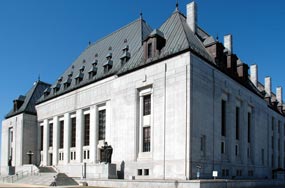Recent court decisions on Aboriginal title are sending tremors through the mining sector in Canada
Canada’s mining sector has taken a beating at the hands of low commodities prices. But for developers whose projects touch on Aboriginal lands, a Supreme Court of Canada decision handed down last year is making an already difficult development climate that much more challenging.
The historic ruling recognized a small semi-nomadic tribe’s claim of Aboriginal title over a large tract of land in central British Columbia. While Aboriginal title exists in law, it’s the first time the court has recognized such a claim, and it was predicted it would open the floodgates to many more.
More than a year after it was handed down, Tsilhqot’in (pronounced chill-KO-tin) is sending tremors through the resource sector, although not necessarily in the way that was expected.
For starters, Aboriginal groups with outstanding title claims – and there are over 100 such cases outstanding – have greater expectations of what companies should do in order to get their approval for a project, says Tom Isaac, who leads the Aboriginal law group at Osler, Hoskin & Harcourt LLP.
Isaac says that’s not completely surprising; what is – and not in a good way – is that some provincial government officials have been quietly making it clear to developers that they won’t get approvals for their project unless they already have a signed deal with the affected Aboriginal groups in place, perhaps to avoid having government permissions challenged if title is later recognized.
The law requires only that there be adequate consultation and reasonable accommodation.
“I want to be clear, this isn’t across the board,” Isaac says. “But we’re seeing examples of officials here and there saying, ‘We’d like you to get the consent of the First Nation before approving your project.’ That’s against the law. There’s no legal requirement for consent and it’s a different message than saying, ‘We’d like you to work really hard and in good faith and act reasonably with First Nations.’
“If it’s not a legal requirement don’t pretend it is. Don’t act as if it is. Don’t impose it or suggest it at a whim. That’s unfair.”
Isaac says the problem it causes is it ties developers’ hands behind their backs before talks even begin, making it more difficult and expensive to get new mining projects going.
“All of a sudden they’re essentially trying to impose an additional requirement that doesn’t give you any wiggle room. Not only do you have to get the government’s consent now on whatever approval or permit you’re looking for, you may have to go out and get another party’s consent where there is no formal process. It’s about doing a benefits agreement.
“It makes it remarkably more difficult, and in some cases impossible, because it then becomes an issue of either negotiating a deal or providing a group exactly what they demand if they decide to dig in their heels. It’s a radical changing of the rules but it’s not even being done legally.”
Another example of the Tsilhqot’in effect can be seen with the decision being cited by the courts in litigation brought by Aboriginal groups who have outstanding title claims.
Saik’uz First Nation and Stellat’en First Nation v. Rio Tinto Alcan Inc. is an early example.
The case was started in 2011 by the Saik’uz and Stellat’en First Nations, who filed suit against Rio Tinto Alcan in connection with a British Columbia dam the company operates to power an aluminum smelter.
The First Nations claimed the dam unreasonably interferes with their – unproven – title and rights, justifying a lawsuit for nuisance and for breach of riparian, or riverbank, rights.
Rio Tinto’s lawyers sought to strike the claim, successfully arguing in a British Columbia court that rights or title can’t form the basis for a claim against a private party before being formally recognized by the court.
But the BC Court of Appeal, citing Tsilhqot’in, overturned the lower court decision and allowed the civil claim to go ahead. “Setting a separate standard for Aboriginal people before they can sue other parties in order to enforce their rights is not only lacking in principle,” the court said, “but could also be argued to be inconsistent with the principle of equality under the Charter of Rights and Freedoms.”
If the suit is allowed to proceed on the merits – and Rio Tinto sought leave to appeal to the Supreme Court – Saik’uz itself may set precedent. The case was filed by First Nations against a company rather than the government, which has access to historical records and other means to defend against Aboriginal claims.
Roy Millen, a partner at Blake, Cassels & Graydon LLP in Vancouver, says one aspect of Saik’uz that jumps out at him is the dam was built before “anybody had any clue what Aboriginal rights and title were.”
If it goes to trial, Millen believes it portends a whole new round of First Nations’ lawsuits stemming from projects that were built decades ago — and applies not just in BC, he says, but right across the country, even where First Nations signed historic treaties with the federal government.
Charles Willms, chair of the Aboriginal law practice group at Fasken Martineau DuMoulin LLP, says Saik’uz raises a fundamental question.
“If First Nations can bring the action against private parties before they prove title, is the relevant limitation act running? If so, is this an invitation for all First Nations to bring actions out of the fear the limitation act will be a bar?”
Alberta’s Court of Queen’s Bench has already cited Saik’uz, in allowing Ominayak v. Penn West Petroleum Ltd. to proceed before title has been proven.
“The industry should be aware of these cases because the risk that goes with them is multiple actions being brought by First Nations who are worried about limitation problems. If they can bring the action today, they could have brought it 15 years ago.”
The Supreme Court of Canada’s decision in Tsilhqot’in has changed the climate not just in the courtroom but outside it as well.
Some First Nations, buoyed by the landmark decision, have signalled they’ll be issuing their own mining laws. In January, for example, the Kaska Nation announced it would be introducing its own laws and regulations for companies operating in its traditional territories — which extend over northern British Columbia, the southeastern Yukon and parts of the Northwest Territories. In May, the Tsilhqot’in did the same, requiring mine developers and other companies to get permission before entering their land.
Willms says First Nations protocols are a good thing, because they make it clear to industry how the group would like to be engaged and consulted with. What First Nations call “laws” may be more problematic.
“The difficulty that I have is that from time to time a First Nation will issue what looks like a law in the face of some pretty clear language from our Supreme Court of Canada that that law probably is not valid.
“The courts could be filled with cases like that. I hope not.”
Another development promising to change the landscape for mine developers in Canada comes from Parliament in Ottawa.
In June, Canada’s federal Minister of Natural Resources announced that the Extractive Sector Transparency Measures Act had come into force. Designed as an anti-corruption measure, the act requires companies operating in extractive industries such as mining to report payments made to governments in aggregate of $100,000 or more. It covers money paid for production entitlements, infrastructure improvements, royalties, taxes and fees.
While it now covers payments made to foreign governments, there is a two-year deferral for Aboriginal governments as Ottawa talks to various stakeholders about the implications.
JoAnn Jamieson, a partner at Lawson Lundell LLP in Calgary, says there are a couple of areas that remain “a little uncertain” for the mining companies that will bear the obligation of reporting.
“One is payments made in a consultative capacity,” she says. “There are situations where there is a rights-bearing community with an organization that will take the lead on consultation with industry. It might not be a ‘government’ as we know it, so there’s a question whether payments will be caught by the Act.
“The other area I’d call a little uncertain is if the organization is acting in a commercial capacity — and sometimes there are band-owned contactors providing goods or services. Would payments apply as to Aboriginal government? Sometimes the payments to the band-owned contractors are being made under the umbrella of an impact-benefit agreement, so that’s when you start getting into that grey area.”
Jamieson says impact-benefit agreements between Aboriginal groups and mine developers have long been considered confidential contracts, and there is pushback with both sides arguing that the transparency act should be applied in such a way that they remain as private arrangement between two parties.
The concern in the business community is that each new payment – if it were to become public – could become the starting point for the next negotiation, a bit like free agency in baseball.
“There will be an initial, probably significant effect, as everybody looks to see what everyone else is doing,” says Millen. “Benefit agreements have always been in an upward spiral. It’s very hard to track because it’s always been confidential, but I’ve never seen any consistent trend towards people paying less money for the impact on Aboriginal territory.
“I think the transparency act means First Nations are going to notice anyone who was paying less than the average previously, and the next time around, and probably going to want more.
“The cost of doing business is going to go up.”
The question is, everyone agrees, when will commodities prices break out of their slump, and start going up as well.





